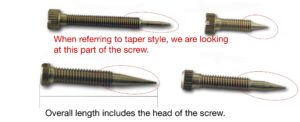Idle Mixture Screws – Adjustments and How to Purchase
The Carburetor Idle Circuit and Adjusting the Idle Mixture
GENERAL KNOWLEDGE
The idle mixture screws sets the mixture of fuel and air during idle RPM; the idle circuit is in effect only when idling. Once RPM increases above idle, the idle mixture screws are no longer in play.
Single barrel carburetors will have one idle mixture screw while 2 barrel and 4 barrel carbs usually have 2 idle mixture screws. The common exception is the Mercarb 2-barrel marine carburetor, which has one idle mixture screw located in the center of the flange.
Turning the idle mixture screws clockwise (in) leans the idle mixture. Turning the idle mixture screws counter clockwise (out) richens the mixture.
For Rochester Quadrajets pick up an idle mixture adjusting tool at most auto parts stores. The tool bends which will make adjusting easier.
DURING REBUILD
Clean the existing screws by buffing them carefully to remove residue. Inspect the tip and thread carefully for grooves. Replace any screw that shows signs of wear or damage.
When assembling the carburetor, turn the idle mixture screws in all the way, gently seat, then turn it out about 1 1/2 turns. DO NOT OVER TIGHTEN, YOU’LL DAMAGE THE SCREW.
FINAL ADJUSTMENTS
Bring the engine up to operating temperature.
Make sure the choke valve is completely open.
You may have to rev the engine slightly so that the fast idle cam moves to the idle position.
Adjust the idle to specification.
There are a couple of ways to adjust the idle mixture.
1. Using a vacuum meter
Hook the vacuum meter to one of the vacuum ports on the intake, or the carburetor.
Take turns with each idle mixture screw.
Turn each screw out a bit for a start (maybe 1 turn).
Turn each screw in 1/4 of a turn and wait for a second for the vacuum meter to catch up.
Do this until you get the smoothest idle and the vacuum meter stays steady.
2. By ear
Turn the mixture screws, alternating between the two in 1/4 turn at a time until the engine rpm starts to drop, then turn them back out 1/4 of a turn.
- blocked idle passage – Passageways are small and ethanol leaves deposits behind that soaking and air won’t always get out. Use a nylon brush when needed to clear deposits in the idle passage. If you blow into the passage from the screw port, you should feel air come out the carb bore.
- damaged or bent screws – purchase new screws and springs anytime you see grooves in the screw tip or thread
- vacuum leak – most common around the base of the carb between the carburetor and manifold, but a vacuum leak can occur at any point of contact.
- idle RMP that is set too high If you have the idle RPM set too high, your idle mixture adjustment will be irrelevant. When you turn the idle mixture screw in all the way and the engine doesn’t change, you could have the idle RPM set too high.

